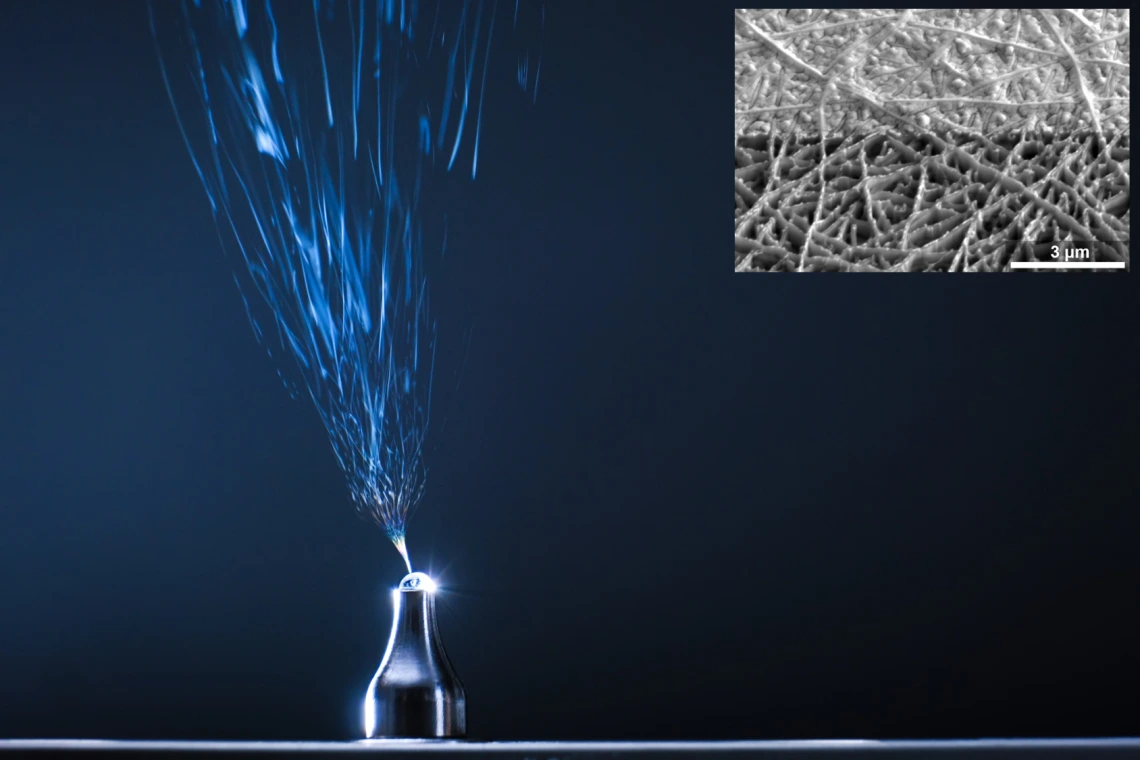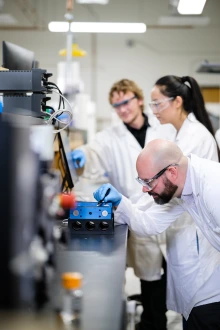Tech Tuesday: Printz prints! Taking high-efficiency thin-film creation to new levels

A microscope image of electrospinning fibers into solution-processed electronic thin films.
Adam Printz
Imagine printing layers 1/100th the thickness of human hairs that can convert light to energy as efficiently as traditional silicon photovoltaics. Now imagine these layers can be printed continuously like newspapers, resulting in lightning-quick manufacturing of high-efficiency photovoltaics at a fraction of the materials usage and costs. University of Arizona researchers have developed a method for achieving exactly this called RAPID, or Restricted Area Printing by Ink Drawing (see invention UA22-194 on the TLA Inventions website).
RAPID is a confined-volume printing technique for solution-processed thin films. Solution-processed thin films are printable electronics that use less material and have a quicker production process than traditional manufacturing processes. These films are also useful for wearable technology as their thinness enables additional mechanical flexibility.

Adam Printz
“With our process, we confine the ink between the substrate being printed onto and a plate above it, which we call a superstrate,” said Adam Printz, an assistant professor of chemical and environmental engineering at the U of A and the lead inventor of RAPID. “By trapping the ink between the substrate and superstrate, we can control the environmental conditions better, allowing us to regulate nucleation and crystallization and produce higher quality films.”
Traditional printing techniques, such as slot-die coating and doctor blading, offer limited control over key processing parameters and cannot precisely adjust factors such as nucleation rates, which directly influence the quality of the resulting thin films. By contrast, the RAPID technique provides enhanced tunability by controlling parameters such as print speed, which affects the formation and growth of nuclei before solvent evaporation. This improved control offers the potential for significantly optimizing thin film production in electronic applications.
“Our initial funding to develop this process had an end-of-project targeted print speed of one linear meter per minute,” Printz said. “Right now, we’re printing high-quality films at 80 meters per minute.”
After earning a bachelor’s degree in finance, Printz was encouraged by Jan Talbot, then-professor of chemical engineering at the University of California San Diego, to pursue a master’s degree in nanoengineering. Printz later earned a Ph.D. in the field at the same institution. His doctoral studies were largely focused on understanding the relationship between morphology and mechanical properties of semiconducting polymeric materials for printable electronics.
He said that his research at the U of A is inspired by previous experience working to mitigate the mechanical fragility of metal halide perovskites, printable materials that excel at absorbing light but are also brittle.
“I look at solution-processable materials predominantly for photovoltaics right now, but I am interested in other applications as well,” Printz said. “The goal for what we do is try to improve the mechanical and chemical stability of these materials in ways that we think are inherently scalable, so that we can apply them in a wide range of applications in optoelectronics, wearable electronics, and computing.”

Clockwise from top left: Ph.D. student Anton Samoylov, Yanan Li (now a postdoc at Dartmouth), and Adam Printz.
Adam Printz
He leads a research group at the U of A that focuses on improving the stability of solution-processable materials in scalable methods. The group consists of undergraduates, Ph.D. students, and postdoctoral scholars. His co-inventors, Matt Dailey and Subham Dastidar, worked on RAPID as part of the Printz Research Group. Dastidar, an alumnus of the group, is a former postdoctoral research fellow and Dailey is currently a Ph.D. student.
“I love doing the research,” Printz said. “But what is most rewarding is seeing the students’ growth in their excitement about the science and really taking ownership of the research.”
In addition to RAPID, Printz is the lead inventor of "Multifunctional Nanofiber Reinforcement for Printable Electronics," UA23-078, which integrates electrospun nanofibers into printable optoelectronic films to improve their stability and toughness. The invention provides a low-cost improvement to the stability of perovskite solar cells by inserting nanofiber reinforcements into cells without sacrificing either efficiency or compatibility with solar cell applications. The project is currently led by Anton Samoylov, a Ph.D. student at the U of A and a NASA Space Technologies Research Graduate Opportunities (NSTRGO) Fellow.
Learn more about this innovation, available for license.
Visit UA22-194, "Restricted Area Printing by Ink Drawing (RAPID) for Solution-Processed Thin Films," to learn more about this innovation and its advantages, and to connect with us about licensing and availability.

